My Cat Broke a Nail, How Do I Treat It? Vet Reviewed Facts & FAQ

Updated on
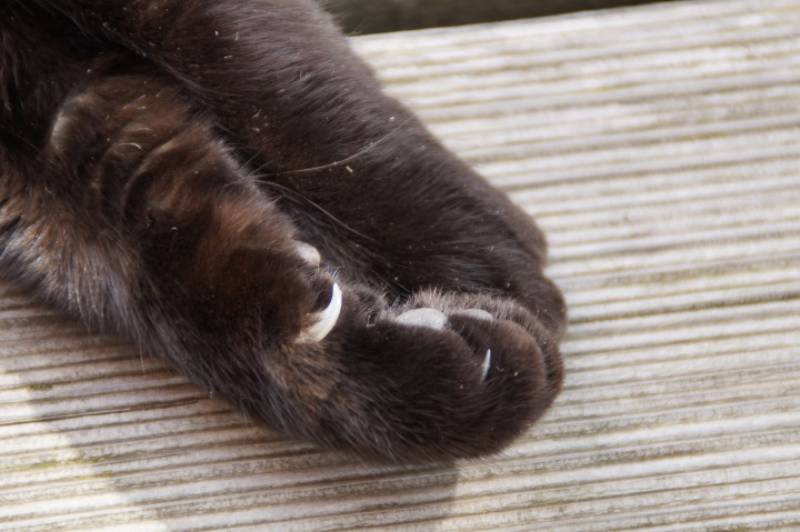
Click to Skip Ahead
As a cat owner, it’s common to be concerned about your feline friend’s health and well-being. One of the most common ailments that cats experience is a broken nail. This can be caused by a variety of factors, including trauma, overgrown nails, or simply catching them on something. A broken nail can be super painful and uncomfortable for your cat, but with the right care, you can help them recover quickly. In this piece, we’ll provide you with a complete guide to treating your cat’s broken nail at home. Let’s discuss.
Reasons Your Cat May Break A Nail
- Your cat’s nail snagged onto something while they were scratching. Examples of such objects include your carpet, upholstery fabrics, or their scratching post.
- Your cat may also break a nail as they jump down from a surface. The impact may cause their nail to bend and break. This commonly happens with overgrown nails.
- Your cat has weak, brittle nails that break easily. At times, such nails are caused by a cat’s genetics, and in such instances, the problem may present itself when your cat is quite young. At other times, they may be caused by poor or improper nutrition, or an underlying health ailment. Senior cats also tend to have weaker, brittle nails that may occasionally break.
Signs Your Cat Has Broken Nail
A broken nail in cats can be easy to spot if you know what to look for. At times, you may witness the moment this happens; as a nail break is painful, your cat may suddenly cry in pain. If you have video recorders in your house, looking over these tapes may help you ascertain where your cat was and what they were doing just before they were injured. This can help you remove the source of injury to prevent future mishaps. Some of the most common signs of a broken nail include limping, licking or biting at the paw, bleeding, and visible damage to the nail. You may also notice that your cat is hesitant to walk or play, or that they seem to be in pain when you touch their paw. If you notice any of these signs, take action right away. A broken nail can be uncomfortable for your cat, and if left untreated, it can lead to infection or more serious injuries.
Cats naturally shed their claw sheaths throughout their lives. You may sometimes find these sheaths around your house. Claw sheath shedding is completely normal, not painful for your cat (your cat won’t show any signs of discomfort), and is NOT accompanied with any bleeding. Older claw sheaths shed and are replaced with a new, healthy nail underneath.
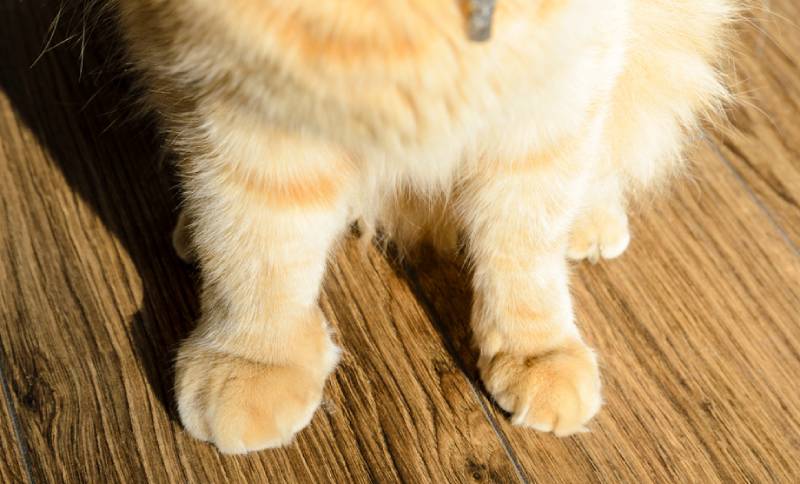
The 3 Steps to Helping With Your Cat’s Broken Nail at Home
1. Assessing Your Cat’s Paw
When assessing your cat’s paw, remember to be gentle and take your time. You don’t want to cause your cat any more pain or discomfort than they’re already feeling.
2. Gently Restrain Your Cat
Start by having someone help you gently restrain your cat. Please note that cats in pain (even the friendliest ones) may sometimes lash out. It might be beneficial to use a towel wrap to gently restrain your cat. Once your cat is restrained, you should gently examine the paw and look for any visible damage to the nail. If your cat isn’t cooperative from the get-go, it’s best to promptly take them to your vet rather than figuring out ways to restrain them.
3. If You Notice Any Bleeding
If you notice any bleeding, try to apply pressure with a clean towel or cloth to help stop the bleeding. If the bleeding doesn’t stop within a few minutes, try applying a styptic pencil or a cauterizing powder to the nail.1 Regardless of whether this controls the bleeding or not, your next priority should be gently wrapping your cat’s paw in a towel and bringing them to your veterinarian.
Overgrown nails can cause all kinds of problems for your cat's paws. Our Hepper Cat Nail Clipper Set includes everything you need to keep your cat's nails safely trimmed. It includes two sizes of stainless steel clippers complete with ergonomic handles and built-in safety guards. This set is perfect for all ages, sizes, and breeds of cats!
What to Expect At the Vet
1. Cleaning the Affected Area
Your vet will likely start by cleaning the affected area with warm water and an appropriate wound cleaning product. This will help remove any dirt or debris that may have gotten into the wound. It’s a good idea to ask your vet for a demonstration of this process in case you have to re-bandage your cat at home in the future. The instructions provided to you might include tips on how to be gentle (yet thorough) and avoid putting excessive pressure on the affected area. Once the area is cleaned, your vet will likely dry it to have a closer look at your cat’s broken nail.
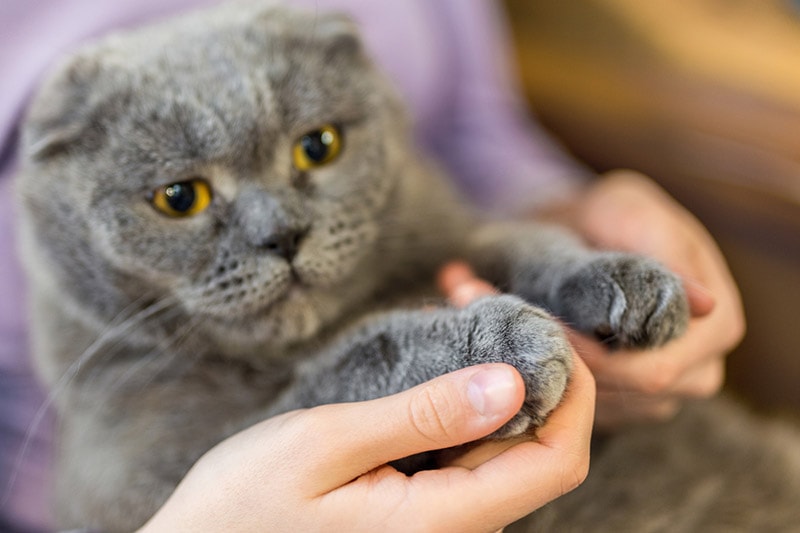
2. Trimming the Nail
Next, your vet will trim the broken nail. It is very important to note that this step can be incredibly painful for cats and while you can definitely clean and gently wrap your cat’s injured paw at home, you should not attempt to remove a dislodged or broken nail, except in cases where the nail is just a loosely attached sliver that’s very easy to trim off.
Your vet will determine the best way to trim the broken nail. As mentioned, this is incredibly painful for most cats. Therefore, this step might involve local anesthesia (for your cat’s paw) or a numbing agent, to lessen the discomfort your cat experiences throughout the ordeal.
3. Preventing Infection
After trimming the nail, your veterinarian will likely disinfect the wound to prevent infection. Your cat may also be prescribed a disinfectant spray or solution, or antibiotics (either topical or oral) by your veterinarian.

4. Bandaging
Once the wound is disinfected, your vet will apply a bandage to help protect the area and keep it clean. They may use products such as a sterile gauze pad or a small piece of adhesive tape. It is a good idea to ask your veterinarian (or their staff) for a demonstration of the process if you’re unsure on how to bandage your cat’s foot yourself. Pay close attention to how they wrap the bandage; it should be snug, but not too tight, to avoid cutting off circulation. You may need to replace the bandage daily or more frequently at home as part of aftercare instructions.
5. Discharge Instructions
Finally, your vet will likely advise you to monitor your cat’s progress and watch for any signs of infection or further injury. You will be instructed on how you can keep the bandage clean and dry and check the paw regularly for any signs of swelling, redness, or discharge. You may probably have to periodically take your cat back to the vet for redressing the wound and applying new bandages, depending on the extent of the injury your cat sustained to their nail. If your cat seems to be in pain, is limping, or is still licking or biting at the paw while at home, it is advised to have them looked at again by your veterinarian sooner than their next appointment.
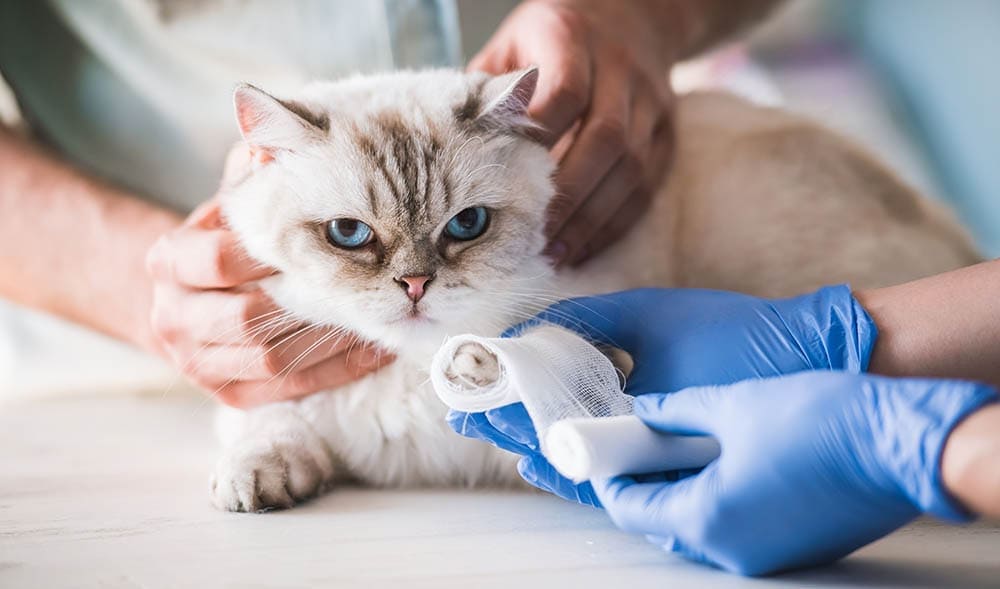
Preventing Broken Nails in Cats
While it’s not always possible to prevent broken nails in cats, there are some steps you can take to reduce the risk. Regular nail trimming is one of the most important things you can do to keep your cat’s nails healthy and prevent them from becoming overgrown or brittle.
You can also provide your cat with scratching posts and other toys to help keep their nails strong and healthy. Additionally, it’s essential to provide your cat with a safe and comfortable environment to play and relax in. This can help reduce the risk of trauma or injury.
If your cat is born with exceptionally brittle nails, you should consult with your veterinarian for appropriate supplements to promote good nail bed growth to support their condition. Likewise, senior cats may require extra supplements for good nail growth and maintenance, to minimize the risk of a nail breaking off. Consult with your veterinarian if you suspect that your cat’s brittle nails are due to a lack of proper nutrition.
When to Seek Veterinary Care for Your Cat’s Broken Nail
While minor cases of broken nails can often be treated at home,it is still best to always have your veterinarian examine a broken nail, to prevent complications from the injury and to provide your cat with appropriate pain control medication depending on the severity of their injury. If your cat is bleeding heavily, is in severe pain, or seems to be unable to walk, always seek veterinary care right away. And if you notice any signs of infection, such as redness, swelling, or discharge, or if your cat is not improving after a few days of home care, it’s best to consult with your veterinarian.
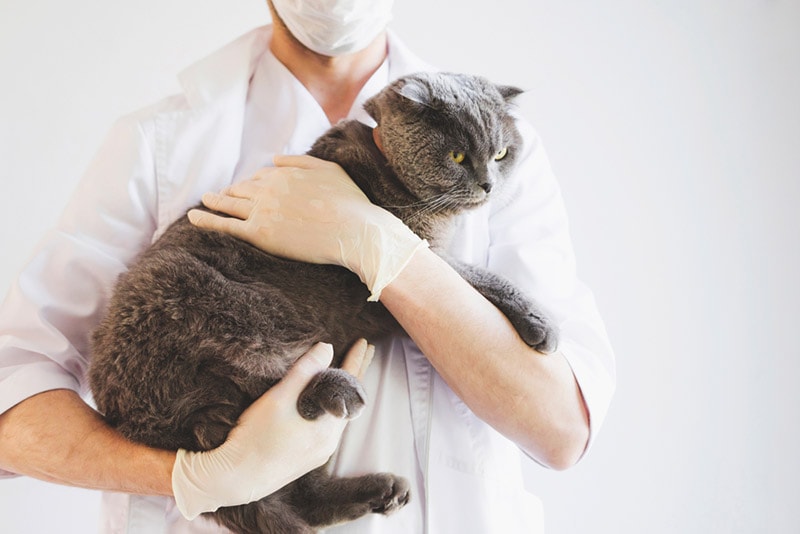
Why Trimming Your Cat’s Claws Regularly Is Important
Trimming your cat’s claws is essential for several reasons. First, it helps prevent your cat from scratching your furniture, carpets, and other household items. Also, it prevents your cat from injuring themselves while scratching. Cat scratches can be painful and can sometimes lead to infections. Trimming your cat’s claws also ensures that they do not get too long, which can cause discomfort and even deformities in their paws. Additionally, trimming your cat’s claws can help prevent accidental scratching during playtime or if your cat becomes scared or agitated.
Frequently Asked Questions About Cat’s Broken Nails
Can a broken nail heal on its own?
In many cases, a broken nail may heal on its own with proper care and attention. However, it’s important to monitor the area closely and seek veterinary care if there are any signs of infection or further injury.
How often should you trim your cat’s claws?
The frequency of trimming your cat’s claws depends on several factors, including the age of your cat, their activity level, and the type of scratching surface they use. Generally, it’s recommended to trim your cat’s claws every 2 to 3 weeks. However, if you notice that your cat’s claws are getting too long or hear them clicking on the floor, it’s time for a trim.

Can I give my cat pain medication for a broken nail?
It’s best to consult with your veterinarian before giving your cat any pain medication. Some over-the-counter pain relievers can be toxic to cats, so it’s important to follow your vet’s guidance.
How can I prevent my cat from breaking their nails?
Regular nail trimming and providing your cat with a safe and comfortable environment can help reduce the risk of broken nails. Additionally, providing your cat with toys and scratching posts can help keep their nails strong and healthy.
Wrapping Things Up
A broken nail can be a painful and uncomfortable experience for your cat, but with the right care, you can help them recover quickly. By following the aforementioned steps, you can effectively identify a case of a broken nail at home and help your cat by gently restraining them and having them checked by your veterinarian. Remember to be gentle, take your time, and monitor your cat’s progress closely. And if you have any concerns or questions, don’t hesitate to consult with your vet. With proper care and attention, your cat will be back to their happy, healthy selves in no time.
Featured Image Credit: JumpStory













